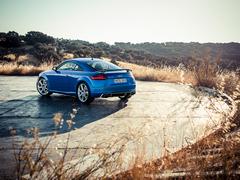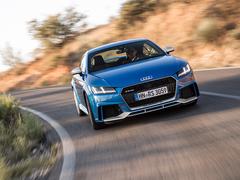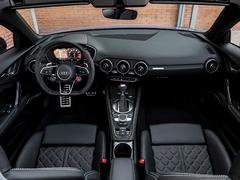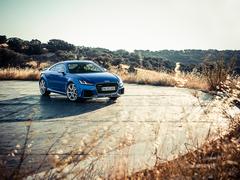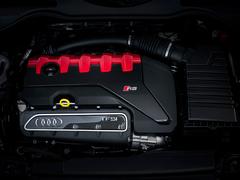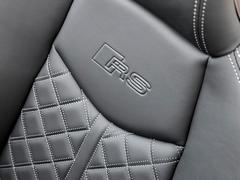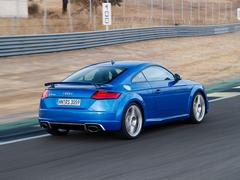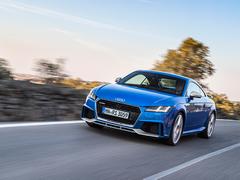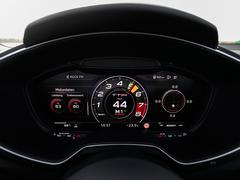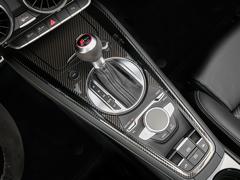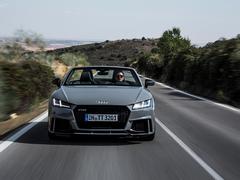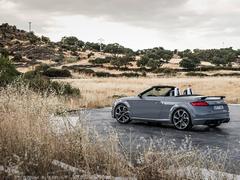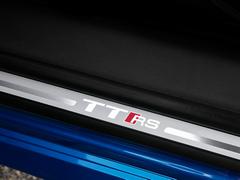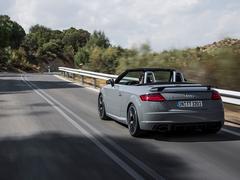Audi TT RS: Review
With the Cayman down to four cylinders, is now the TT's time to shine?
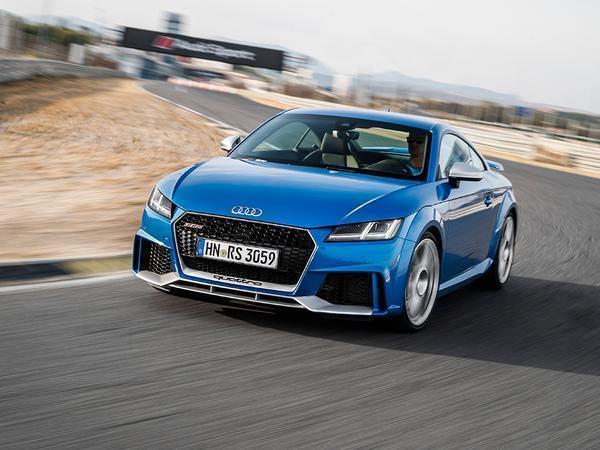
And why shouldn't it? Even after all these years - it has won its Engine of the Year category seven times in a row - it remains absolutely tremendous. For this car, the engine has shed 26kg thanks mainly to an aluminium crankcase (saving 18kg) but also lighter con-rods, lighter pistons and a new cylinder head as well; a useful saving given the fairly unfavourable distribution of mass. For reference the claimed kerbweight is 1,515kg for a Coupe to EU standards, against 1,570kg for a BMW M2 and 1,430kg for a 718 Cayman.
Neither of those engines has 400hp though, or such an ability to worm its way into your affections. Yes, even the BMW. While the Audi 2.5 may not feel quite as revvy as it may once have - the Porsche flat-four is probably a little keener in fact - the five-cylinder's combination of performance, usability, character and noise remains deeply endearing.
5, 4, 3, 2, 1 - go!
There's more lag than you'll notice in either the BMW or the Porsche, but then a fantastically exciting torrent of boost thereafter. Peak power is made from 5,850-7,000rpm, so you'll find yourself hanging onto gears to go faster and faster still. And for the noise, of course. Much like the RS3, Audi has ensured there will never be any doubt as to this car's cylinder count, regardless of whether you actually want people knowing or not. With the sport exhaust off, the TT RS is just a throttle prod away from every Mikkola-in-the-forest analogy you care to think of. With it on the noise becomes almost an onslaught; jolly good fun for a while, but the car actually sounds more authentic with it off.
So the engine is great. But that was largely a given. What was less assured was whether this second generation RS could make amends for the original five-pot TT's rather ordinary dynamics. Certainly it's where the M2 and Cayman, as well as perhaps an F-Type V6 Coupe, will be eager to claim back some ground.
The big news for this fast Audi is that the Quattro torque split is now included into the familiar drive select control. So on top of the usual dynamic parameters, the driver can now adjust how the power is distributed. This in addition to a new multi-plate clutch for the Quattro system, lighter than before and mounted at the back for better weight distribution. Sounds promising, doesn't it? Sadly this TT hasn't emulated its Ford Focus namesake; this is still a Haldex system and, regardless of Audi's claims, there's no situation where the driver senses 100 per cent of the torque going to either end. Torque vectoring is of the brake activated kind too, rather than a more proactive system.
Push/pull
On circuit the result is a car that feels - you've guessed it - largely dictated by its front. Even out of Jarama's slower corners, the RS feels much more to be pulling out through its front wheels rather than being pushed out from the back. Which isn't really all that fun. This isn't simply an unreasonable journalist demanding oversteer everywhere, but it means the car simply has very limited cornering options. You brake, you turn, you power out. Fast, certainly, and extremely competent, but nowhere near as engaging or rewarding as the other two. Sorry.
For the track cars, Audi didn't permit anything more than ESC Sport to be engaged. For those cars used on the road, everything could be turned off. Go figure. It doesn't reveal a whole new side to the dynamic character though, certainly at road speeds. With 255-section Pirelli P-Zero tyres, grip from the TT RS is huge and there's never any impression of that ceding. You brake, you turn, you power out.
That being said, on road and at a more sensible pace, the RS is entirely pleasant. The brakes aren't as snatchy as the typical fast VW fare, the gearbox is decisive enough (where it wasn't always on track) and it often feels more agile than that weight would suggest. And there's always that noise, of course.
All of the test cars were fitted with the optional magnetic dampers and 20-inch wheels. Though the dealer will probably advise against so for resale, it would seem wise to try the standard set up if possible. Certainly the ride improves with speed, but the low speed choppiness seems a bit much. Perhaps that's one to be sure of in the UK.
Points for style
But if these sound like familiar criticisms - yes, the steering is always a little numb too - then the TT RS also comes with many familiar (and very pleasant) attributes. The interior is, as expected, absolutely glorious, worthy of a car more expensive and comfortably ahead of both the BMW and the Porsche. Once you've finished admiring the cabin you'll notice the driving position is very good too, with the driver sat low and the wheel able to be pulled right out. It looks fantastic outside also. As a feelgood sports car experience, the combination of the quality, the powertrain and the styling will be enough for many customers, both returning and conquest.
As a sports car for drivers though, the TT RS still leaves something to be desired. There's no doubting the performance or the outright ability, but so much of the subjective charm that sports cars should possess - the involvement, the entertainment and the fun - isn't really there. That probably won't matter to many potential customers, but from a PH perspective the TT RS doesn't quite cut it. The M2 or a Cayman, the latter even with a four-cylinder engine, remain the more rewarding sports cars.
AUDI TT RS
Engine: 2,480cc, five-cyl turbocharged
Transmission: 7-speed S-tronic dual-clutch, all-wheel drive
Power (hp): 400@5,850-7,000rpm
Torque (lb ft): 354@1,700-5,850rpm
0-62mph: 3.7sec
Top speed: 155mph (174mph optional)
Weight: 1,515kg (EU unladen)
MPG: 34.4 (NEDC combine)
CO2: 187g/km
Price: £51,800 (Coupe), £53,550 (Roadster)
it's one thing for a family hatch with a ballistic 5 pot to be a bit numb / push on the limit it's a very different thing for a sports car to do it
i used my RS3 as a daily for 5 years, i would take a caymen over the TT every single time even with the 4 pot
Gassing Station | General Gassing | Top of Page | What's New | My Stuff

